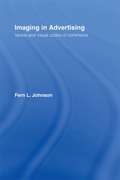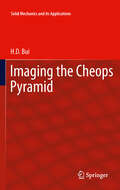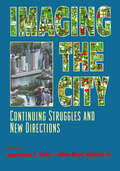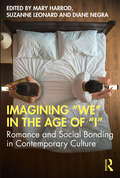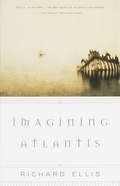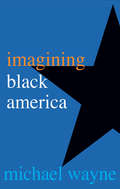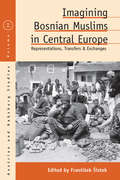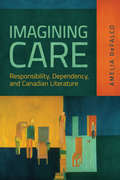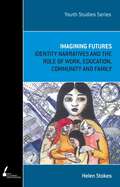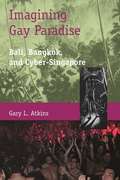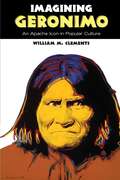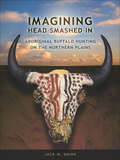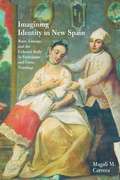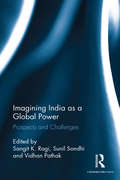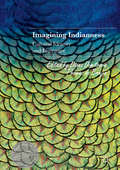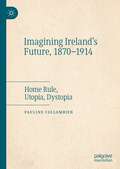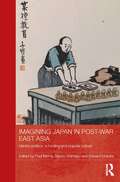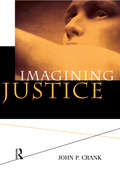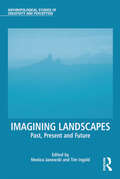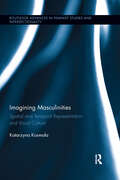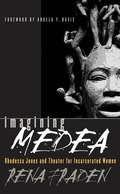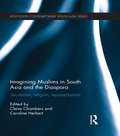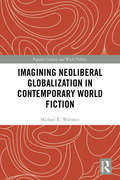- Table View
- List View
Imaging in Advertising: Verbal and Visual Codes of Commerce
by Fern L. JohnsonThe dominance of advertising in everyday life carries potent cultural meaning. As a major force in the rise of "image based culture," advertising spreads images that shape how people live their lives. While scholarship on visual images has advanced our understanding of the role of advertising in society, for example in revealing how images of extremely thin female models and athletic heroes shape ideals and aspirations, images circulated through lagnuage codes--or "verbal images"--in advertising have received less attention. Imaging in Advertising explores how the verbal and visual work together to build a discourse of advertising that speaks to audiences and has the power to move them to particular thoughts and actions. In this book, Fern L. Johnson presents a series of case studies exploring important advertising images--racial connotations in cigarette advertising, representations of cultural diversity in teen television commercials, metaphors of the face appearing in ads for skin care products, language borrowed from technology to sell non-technology products, and the illusion of personal choice that is promoted in many Internet web sites. Johnson argues that examining the interplay of verbal and visual images as a structured whole exposes the invase role of advertising in shaping culture in 21st century America.
Imaging the Cheops Pyramid
by H. D. BuiIn this book Egyptian Archeology and Mathematics meet. The author is an expert in theories and applications in Solid Mechanics and Inverse Problems, a former professor at Ecole Polytechnique and now works with Electricité de France on maintenance operations on nuclear power plants. In the Autumn of 1986, after the end of the operation on the King's chamber conducted under the Technological and Scientific Sponsorship of EDF, to locate a cavity, he was called to solve a mathematical inverse problem, to find the unknown tomb of the King and the density structure of the whole pyramid based on measurements of microgravity made inside and outside of the pyramid. This book recounts the various search operations on the pyramid of Cheops made at the request of the Egyptian and French authorities in 1986-1987. After the premature end of the Cheops operation in the Autumn of 1986, following the fiasco of unsuccessful drillings in the area suspected by both architects G. Dormion and J.P. Goidin and microgravity auscultation, EDF and CPGF (a geophysical company) teams continued their researches with measurements already made, trying this time an inversion of the Newton gravity equation for the entire pyramid and using another theoretical team led by the author. The inverse problem solution confirmed the results of auscultations, but found no cavity. However, the image of the average density at the surface of the entire pyramid forms a sort of square "spiral" probably related to the construction method. In 2000, Jean-Pierre Houdin considered the author's results of 1988 as a confirmation of his theory of the internal ramp tunnel. Since then the author has done additional research and found that classical theories of the construction based on degrees and the particular mode of stones filling can also report the same densitogram. The book is richly illustrated with color figures. It is dotted with information concerning Physics, Mechanics and the History of Egyptian Antiquities. The book ends with the greatest mystery of the pyramid about the unknown tomb of the King and a dream to see the tomb at an unexpected place.
Imaging the City: Continuing Struggles and New Directions
by Jr. WarnerPlanners face a controversial task because their professional role requires them to be spokespersons for the public interest. In a welter of conflicting pictures and voices, how might the public interest be discovered? Once identified, how might it be expressed so that competing publics attend to it? There are no easy answers, but the experience of planners today suggests ways of working and innovations of promise.The focus on planning practice prompted the editors to analyze images that are now at work in our cities. For Vale and Warner, all city design and constructions offer material that people should include in images of their environment. The built and building city are part of the experience of all city dwellers; it is theirs to incorporate, interpret, or ignore. Essays included in this text trace the interplay between physical objects of planners and architects and the social experience and outlooks of image makers and their audiences.Imaging the City explores urban image making from civic boosterism of medieval cities to iconic imagery of Times Square. Vale and Warner bring together urban historians, geographers, city planners, architects, and cultural commentators to analyze the creation of urban imagery from the signature skyscrapers of Kuala Lumpur to the re-creation of the South Bronx and the use of city images in film, literature, television, and on the Internet. Urban dwellers, urban planners, architects, municipal officials, sociologists, urban historians - all will perceive their worlds with a heightened sense of awareness after reading this book.
Imagining "We" in the Age of "I": Romance and Social Bonding in Contemporary Culture
by Mary Harrod, Suzanne Leonard and Diane NegraIn the early twenty-first century shifts in gender and sexuality, work and mobility patterns and especially technology have provoked interest in perceived threats to social bonding on a global scale. This edited collection explores the fracturing of couple culture but also its persistence. Looking at a variety of media sites—including film, television, popular print fiction, new media and new technologies—this volume’s diverse range of contributors examine how mediated scenes of intimacy proliferate, while real-life experiences are cast in a newly uncertain light. The collection thus challenges a latent but growing tendency towards perceptions of romantic decline, in a variety of cultural contexts and with attention to the impact of COVID-19. This is an accessible and timely collection suitable for scholars in gender studies, media, cultural studies and communication studies.
Imagining Atlantis
by Richard EllisEver since Plato created the legend of the lost island of Atlantis, it has maintained a uniquely strong grip on the human imagination. For two and a half millennia, the story of the city and its catastrophic downfall has inspired people--from Francis Bacon to Jules Verne to Jacques Cousteau--to speculate on the island's origins, nature, and location, and sometimes even to search for its physical remains. It has endured as a part of the mythology of many different cultures, yet there is no indisputable evidence, let alone proof, that Atlantis ever existed. What, then, accounts for its seemingly inexhaustible appeal?Richard Ellis plunges into this rich topic, investigating the roots of the legend and following its various manifestations into the present. He begins with the story's origins. Did it arise from a common prehistorical myth? Was it a historical remnant of a lost city of pre-Columbians or ancient Egyptians? Was Atlantis an extraterrestrial colony? Ellis sifts through the "scientific" evidence marshaled to "prove" these theories, and describes the mystical and spiritual significance that has accrued to them over the centuries. He goes on to explore the possibility that the fable of Atlantis was inspired by a conflation of the high culture of Minoan Crete with the destruction wrought on the Aegean world by the cataclysmic eruption, around 1500 b.c., of the volcanic island of Thera (or Santorini).A fascinating historical and archaeological detective story, Imagining Atlantis is a valuable addition to the literature on this essential aspect of our mythohistory.From the Hardcover edition.
Imagining Autism
by Sonya Freeman LoftisA disorder that is only just beginning to find a place in disability studies and activism, autism remains in large part a mystery, giving rise to both fear and fascination. Sonya Freeman Loftis's groundbreaking study examines literary representations of autism or autistic behavior to discover what impact they have had on cultural stereotypes, autistic culture, and the identity politics of autism. Imagining Autism looks at fictional characters (and an author or two) widely understood as autistic, ranging from Conan Doyle's Sherlock Holmes and Harper Lee's Boo Radley to Mark Haddon's boy detective Christopher Boone and Steig Larsson's Lisbeth Salander. The silent figure trapped inside himself, the savant made famous by his other-worldly intellect, the brilliant detective linked to the criminal mastermind by their common neurology--these characters become protean symbols, stand-ins for the chaotic forces of inspiration, contagion, and disorder. They are also part of the imagined lives of the autistic, argues Loftis, sometimes for good, sometimes threatening to undermine self-identity and the activism of the autistic community.
Imagining Black America
by Michael WayneScientific research has now established that race should be understood as a social construct, not a true biological division of humanity. In Imagining Black America, Michael Wayne explores the construction and reconstruction of black America from the arrival of the first Africans in Jamestown in 1619 to Barack Obama's reelection. Races have to be imagined into existence and constantly reimagined as circumstances change, Wayne argues, and as a consequence the boundaries of black America have historically been contested terrain. He discusses the emergence in the nineteenth century-and the erosion, during the past two decades-of the notorious "one-drop rule." He shows how significant periods of social transformation-emancipation, the Great Migration, the rise of the urban ghetto, and the Civil Rights Movement-raised major questions for black Americans about the defining characteristics of their racial community. And he explores how factors such as class, age, and gender have influenced perceptions of what it means to be black. Wayne also considers how slavery and its legacy have defined freedom in the United States. Black Americans, he argues, because of their deep commitment to the promise of freedom and the ideals articulated by the Founding Fathers, became and remain quintessential Americans-the "incarnation of America," in the words of the civil rights leader A. Philip Randolph.
Imagining Bosnian Muslims in Central Europe: Representations, Transfers and Exchanges (Austrian and Habsburg Studies #32)
by František ŠístekAs a Slavic-speaking religious and ethnic “Other” living just a stone’s throw from the symbolic heart of the continent, the Muslims of Bosnia and Herzegovina have long occupied a liminal space in the European imagination. To a significant degree, the wider representations and perceptions of this population can be traced to the reports of Central European—and especially Habsburg—diplomats, scholars, journalists, tourists, and other observers in the late nineteenth and early twentieth centuries. This volume assembles contributions from historians, anthropologists, political scientists, and literary scholars to examine the political, social, and discursive dimensions of Bosnian Muslims’ encounters with the West since the nineteenth century.
Imagining Care: Responsibility, Dependency, and Canadian Literature
by Amelia DefalcoImagining Care brings literature and philosophy into dialogue by examining caregiving in literature by contemporary Canadian writers alongside ethics of care philosophy. Through close readings of fiction and memoirs by Margaret Atwood, Alice Munro, Michael Ignatieff, Ian Brown, and David Chariandy, Amelia DeFalco argues that these narratives expose the tangled particularities of relations of care, dependency, and responsibility, as well as issues of marginalisation on the basis of gender, race, and class.DeFalco complicates the myth of Canada as an unwaveringly caring nation that is characterized by equality and compassion. Caregiving is unpredictable: one person's altruism can be another's narcissism; one's compassion, another's condescension or even cruelty. In a country that conceives of itself as a caring society, these texts depict in stark terms the ethical dilemmas that arise from our attempts to respond to the needs of others.
Imagining Futures: Identity Narratives and the Role of Work, Education, Community and Family
by Helen StokesYoung people consider their future at a stage of life when the structure and relative certainty of school and further education are about to be left behind. This book provides an insight into how young people see themselves, the options they think are available to them and the strategies they use to make their imagined futures possible.Ultimately, Imagining Futures is about identity. It draws on the real-life stories and voices of a range of young people—many of whom are in their final years of secondary school or TAFE—to present an eye-opening portrait who they are, who they aim to become and how.
Imagining Gay Paradise: Bali, Bangkok, and Cyber-Singapore
by Gary L. AtkinsThis look at gay paradises in Southeast Asia and the men who created them considers the obstacles gay men have faced in securing a voice as citizens, and how they have used images of paradise in Bali, Bangkok, and Singapore to create a sense of refuge, construct homes for themselves, and dissent from typical notions of manhood and masculinity. It focuses on Walter Spies, a gay German painter; Khun Thc, who founded an architectural paradise called Babylon in Thailand during the reign of King Rama VI; and the "cyber-paradise" of Fridae. com created by a young Singaporean named Stuart Koe.
Imagining Gender in Biographical Fiction (Palgrave Studies in Life Writing)
by Julia Novak Caitríona Ní DhúillThis volume addresses the current boom in biographical fictions across the globe, examining the ways in which gendered lives of the past become re-imagined as gendered narratives in fiction. Building on this research, this book is the first to address questions of gender in a sustained and systematic manner that is also sensitive to cultural and historical differences in both raw material and fictional reworking. It develops a critical lens through which to approach biofictions as ‘fictions of gender’, drawing on theories of biofiction and historical fiction, life-writing studies, feminist criticism, queer feminist readings, postcolonial studies, feminist art history, and trans studies. Attentive to various approaches to fictionalisation that reclaim, appropriate or re-invent their ‘raw material’, the volume assesses the critical, revisionist and deconstructive potential of biographical fictions while acknowledging the effects of cliché, gender norms and established narratives in many of the texts under investigation. The introduction of this book is available open access under a CC BY 4.0 license at link.springer.com
Imagining Geronimo: An Apache Icon in Popular Culture
by William M. ClementsHis face has appeared on T-shirts, postage stamps, jigsaw puzzles, posters, and an Andy Warhol print. A celebrity and a tourist attraction who attended three World&’s Fairs and rode in President Theodore Roosevelt&’s inaugural parade, he is a character in such classic westerns as Stagecoach and Broken Arrow. His name was used in the daring military operation that killed Osama bin Laden in 2011, and rumors about the location of his skull at a Yale University club have circulated for a century. These are just a few of the ways that the Apache shaman and war leader known to Anglo-Americans as Geronimo has remained alive in the mainstream American imagination and beyond.Clements&’s study samples the repertoire of Geronimo stories and examines Americans&’ changing sense of Geronimo in terms of traditional patterns—trickster social bandit, patriot chief, sage elder, and culture hero. He looks at the ways in which Geronimo tried with mixed results to maintain control of his own image during more than twenty years in which he was a prisoner of war. Also examined are Geronimo&’s ostensible conversion to Christianity and his image in photography and literature.
Imagining Head Smashed In: Aboriginal Buffalo Hunting on the Northern Plains
by Jack W BrinkAt the place known as Head-Smashed-In in southwestern Alberta, Aboriginal people practiced a form of group hunting for nearly 6,000 years before European contact. The large communal bison traps of the Plains were the single greatest food-getting method ever developed in human history. Hunters, working with their knowledge of the land and of buffalo behaviour, drove their quarry over a cliff and into wooden corrals. The rest of the group butchered the kill in the camp below. Author Jack Brink, who devoted 25 years of his career to “The Jump,” has chronicled the cunning, danger, and triumph in the mass buffalo hunts and the culture they supported. He also recounts the excavation of the site and the development of the Head-Smashed-In Buffalo Jump Interpretive Centre, which has hosted 2 million visitors since it opened in 1987. Brink’s masterful blend of scholarship and public appeal is rare in any discipline, but especially in North American pre-contact archaeology.
Imagining Identity in New Spain: Race, Lineage, and the Colonial Body in Portraiture and Casta Paintings
by Magali M. CarreraReacting to the rising numbers of mixed-blood (Spanish-Indian-Black African) people in its New Spain colony, the eighteenth-century Bourbon government of Spain attempted to categorize and control its colonial subjects through increasing social regulation of their bodies and the spaces they inhabited. <P><P>The discourse of calidad (status) and raza (lineage) on which the regulations were based also found expression in the visual culture of New Spain, particularly in the unique genre of casta paintings, which purported to portray discrete categories of mixed-blood plebeians.
Imagining India as a Global Power: Prospects and Challenges
by Sangit K. Ragi Sunil Sondhi Vidhan PathakThis book provides a comprehensive understanding of the various dimensions of India’s international positioning and foreign relations. Already a dominant player in South Asian politics, India has gained a strong footing in the international pecking order with the signing of the Indo-US nuclear agreement and significant support for its claim for a permanent seat in the Security Council. The chapters presented here look at myriad aspects — India’s relations with its neighbours and global powers farther afield including the US, the European Union, Russia and China; India’s policies, influences and strengths; developments in economy, knowledge and innovation amid evolving global realities as well as geostrategic equations and alliances; its present and future plans vis-à-vis its standing in the world; and how international politics is likely to emerge in the coming years. <P><P>The volume will be useful to academics, researchers and students of politics and international relations as also to policy practitioners and those in media interested in Indian affairs, foreign policy and international relations.
Imagining Indianness
by Diana Dimitrova Thomas BruijnThis book brings together several important essays examining the interface between identity, culture, and literature within the issue of cultural identity in South Asian literature. The book explores how one imagines national identity and how this concept is revealed in the narratives of the nation and the production of various cultural discourses. The collection of essays examines questions related to the interpretation of the Indian past and present, the meanings of ancient and venerated cultural symbols in ancient times and modern, while discussing the ideological implications of the interpretation of identity and "Indianness" and how they reflect and influence the power-structures of contemporary societies in South Asia. Thus, the book studies the various aspects of the on-going process of constructing, imagining, re-imagining, and narrating "Indianness", as revealed in the literatures and cultures of India.
Imagining Ireland's Future, 1870-1914: Home Rule, Utopia, Dystopia
by Pauline CollombierThis book attempts to delve into the connection between imagination and politics, and examines the many expectations and fears engendered by the Irish home rule debate. More specifically, it assesses the ways politicians, artists and writers in Ireland, Britain and its empire imagined how self-government would work in Ireland after the restitution of an Irish parliament. What did home rulers want? What were British supporters of Irish self-government willing to offer? What did home rule mean not only to those who advocated it but also to those who opposed it?
Imagining Japan in Post-war East Asia: Identity Politics, Schooling and Popular Culture (Routledge Studies in Education and Society in Asia)
by Paul Morris Edward Vickers Naoko ShimazuIn the decades since her defeat in the Second World War, Japan has continued to loom large in the national imagination of many of her East Asian neighbours. While for many, Japan still conjures up images of rampant military brutality, at different times and in different communities, alternative images of the Japanese ‘Other’ have vied for predominance – in ways that remain poorly understood, not least within Japan itself. Imagining Japan in Postwar East Asia analyses the portrayal of Japan in the societies of East and Southeast Asia, and asks how and why this has changed in recent decades, and what these changing images of Japan reveal about the ways in which these societies construct their own identities. It examines the role played by an imagined ‘Japan’ in the construction of national selves across the East Asian region, as mediated through a broad range of media ranging from school curricula and textbooks to film, television, literature and comics. Commencing with an extensive thematic and comparative overview chapter, the volume also includes contributions focusing specifically on Chinese societies (the mainland PRC, Hong Kong and Taiwan), Korea, the Philippines, Malaysia and Singapore. These studies show how changes in the representation of Japan have been related to political, social and cultural shifts within the societies of East Asia – and in particular to the ways in which these societies have imagined or constructed their own identities. Bringing together contributors working in the fields of education, anthropology, history, sociology, political science and media studies, this interdisciplinary volume will be of interest to all students and scholars concerned with issues of identity, politics and culture in the societies of East Asia, and to those seeking a deeper understanding of Japan’s fraught relations with its regional neighbours.
Imagining Justice
by John P. CrankImagining Justice seeks to move away from normative thinking about justice, particularly in the area of justice education, suggesting that what is needed today is a way to think about the enterprise of justice that will capture its full potential. By providing an introduction to the intellectual potential of the field of justice, we can acknowledge that the field is wider than formerly recognized, and ultimately imagine the full richness that justice can encompass.
Imagining Landscapes: Past, Present and Future (Anthropological Studies of Creativity and Perception)
by Tim Ingold Monica JanowskiThe landscapes of human habitation are not just perceived; they are also imagined. What part, then, does imagining landscapes play in their perception? The contributors to this volume, drawn from a range of disciplines, argue that landscapes are 'imagined' in a sense more fundamental than their symbolic representation in words, images and other media. Less a means of conjuring up images of what is 'out there' than a way of living creatively in the world, imagination is immanent in perception itself, revealing the generative potential of a world that is not so much ready-made as continually on the brink of formation. Describing the ways landscapes are perpetually shaped by the engagements and practices of their inhabitants, this innovative volume develops a processual approach to both perception and imagination. But it also brings out the ways in which these processes, animated by the hopes and dreams of inhabitants, increasingly come into conflict with the strategies of external actors empowered to impose their own, ready-made designs upon the world. With a focus on the temporal and kinaesthetic dynamics of imagining, Imagining Landscapes foregrounds both time and movement in understanding how past, present and future are brought together in the creative, world-shaping endeavours of both inhabitants and scholars. The book will appeal to anthropologists, sociologists and archaeologists, as well as to geographers, historians and philosophers with interests in landscape and environment, heritage and culture, creativity, perception and imagination.
Imagining Masculinities: Spatial and Temporal Representation and Visual Culture
by Katarzyna KosmalaThis book examines the intersections between debates in critical studies of men and masculinities and debates on visual representation, investigating representations of men and masculinities in contemporary culture and examples of visual art that deconstruct those representations. It attends to various spaces associated with heteronormativity, including the visible domains of working life, leisure and public discourses, as well as less visible domains such as private spaces, lifestyle, desire and sexual agency.
Imagining Medea
by Rena FradenThis ain't no Dreamgirls," Rhodessa Jones warns participants in the Medea Project, the theater program for incarcerated women that she founded and directs. Her expectations are grounded in reality, tempered, for example, by the fact that women are the fastest growing population in U.S. prisons. Still, Jones believes that by engaging incarcerated women in the process of developing and staging dramatic works based on their own stories, she can push them toward tapping into their own creativity, confronting the problems that landed them in prison, and taking control of their lives. Rena Fraden chronicles the collaborative process of transforming incarcerated women's stories into productions that incorporate Greek mythology, hip-hop music, dance, and autobiography. She captures a diverse array of voices, including those of Jones and other artists, the sheriff and prison guards, and, most vividly, the women themselves. Through compelling narrative and thoughtful commentary, Fraden investigates the Medea Project's blend of art and activism and considers its limits and possibilities for enacting social change.Rhodessa Jones is co-artistic director of the San Francisco-based performance company Cultural Odyssey and founder of the Medea Project: Theater for Incarcerated Women. An award-winning performer, she has taught at the Yale School of Drama and the New College of California.
Imagining Muslims in South Asia and the Diaspora: Secularism, Religion, Representations (Routledge Contemporary South Asia Series)
by Claire Chambers Caroline HerbertLiterary, cinematic and media representations of the disputed category of the ‘South Asian Muslim’ have undergone substantial change in the last few decades and particularly since the events of September 11, 2001. Here we find the first book-length critical analysis of these representations of Muslims from South Asia and its diaspora in literature, the media, culture and cinema. Contributors contextualize these depictions against the burgeoning post-9/11 artistic interest in Islam, and also against cultural responses to earlier crises on the subcontinent such as Partition (1947), the 1971 Indo-Pakistan war and secession of Bangladesh, the 1992 Ayodhya riots , the 2002 Gujarat genocide and the Kashmir conflict. Offering a comparative approach, the book explores connections between artists’ generic experimentalism and their interpretations of life as Muslims in South Asia and its diaspora, exploring literary and popular fiction, memoir, poetry, news media, and film. The collection highlights the diversity of representations of Muslims and the range of approaches to questions of Muslim religious and cultural identity, as well as secular discourse. Essays by leading scholars in the field highlight the significant role that literature, film, and other cultural products such as music can play in opening up space for complex reflections on Muslim identities and cultures, and how such imaginative cultural forms can enable us to rethink secularism and religion. Surveying a broad range of up-to-date writing and cultural production, this concise and pioneering critical analysis of representations of South Asian Muslims will be of interest to students and academics of a variety of subjects including Asian Studies, Literary Studies, Media Studies, Women’s Studies, Contemporary Politics, Migration History, Film studies, and Cultural Studies.
Imagining Neoliberal Globalization in Contemporary World Fiction (Popular Culture and World Politics)
by Michael WalonenWe are in the midst of the third tectonic social transformation in human history. Our current transition toward greater forms of transnational interconnection, consumption- and finance-driven rather than production-based capitalism, digital information and cultural flows, and the attendant large-scale social and ecological consequences of these are drastically remaking our world, cultural producers from across the globe are seeking to make sense of, and provide insights into, these complex changes. Imagining Neoliberal Globalization in Contemporary World Fiction takes a broad cross-cultural approach to analyzing the literature of our increasingly transnationalized world system, considering how its key constituent features and local-level manifestations have been thematized and imaginatively seized upon by literary fiction produced from the perspective of the periphery of the capitalist world system. Textual renderings of globalization are not simply second-order approximations of it, but constitutive elements of globalization that condition how it will be understood and responded to, and so coming to terms with the narrativizations of globalization is vital scholarly work, as, among other things, it allows us to see to what extent it is currently possible to imagine alternatives to globalization’s more baleful aspects. This work will be of interest to students and scholars across a range of areas including contemporary literary/cultural studies, globalization studies, international relations, and international political economy.
